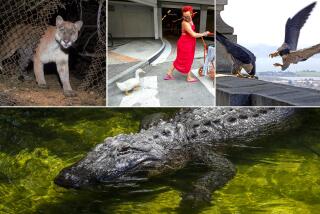Animal’s Bad Reputation Undeserved, Owners Say : Ferret-Face Becomes Pet Name
WILLOW HILL, Pa. — Those much-maligned mischief makers with a badger’s face and a weasel’s body have been getting a bum rap, say a growing number of ferret fanciers.
In fact, the smelly little relative of the European polecat, which was largely unwelcome in the United States until recent years, may be the hottest new pet of the ‘80s. The ferret fanciers have created a multimillion-dollar industry.
“They’re the ultimate pet,” said Marcus Schneck, 29, of State College, who owns two ferrets. “They time themselves exactly to their owners. They generally sleep while you’re not at home, and wake up and play when you are at home.”
Ferrets were domesticated in Egypt more than 3,000 years ago and were brought into the United States more than 100 years ago. However, they’ve become legal as pets in most parts of this country only in the last decade, said Chuck Morton, owner of Path Valley Farms, the nation’s largest pet ferret farm.
Now, more than 50,000 ferrets are produced annually in the United States, mostly by commercial breeders, said Morton, who has more orders than he can fill.
The price of a ferret averages $125 to $175, which usually includes descenting and spaying or neutering. Accessories like cages, leashes, collars and food bowls can come to another $100 to $150. In all, he says, it amounts to a $10-million-a-year business.
Although their name evokes derisive images like “ferret-faced” and intense ones like “ferreting out,” the little mammals shouldn’t be judged by the rest of their mustela family, which includes ill-humored little carnivores like the weasel, mink, skunk, marten, ermine and wolverine.
“Everyone pictures a ferret as a nasty little animal that kills everything in its path,” Morton said. “They’re confused with everything from Rikki-Tikki-Tavi, who’s a mongoose that ate snakes, to weasels that people think will get out and eat every chicken in the coop.”
Ferrets are friendly and huggable, Morton said. By contrast, weasels and the other members of the mustela family are meaner than a treed bear.
“Ferrets are related to the other members of the mustela family the same way dogs are related to wolves,” Morton said.
“Domestic animals tend to accept man’s values as their own. Wild animals can sometimes be made tolerable through fear or conditioning, but you’ll never make them like it.”
Seven years ago, Morton, 42, and his wife, Lynn, 35, bought a rolling, 10-acre spread in Willow Hill in south-central Pennsylvania and started breeding 10 ferrets.
Today, they annually sell 12,000 to 14,000 ferrets from a running population of 2,500 to 3,000 animals, filling only one-third of their orders. They have 19 employees, including a crew of teen-agers who play with the kits, or baby ferrets, to get them used to being handled.
“The demand for ferrets is absolutely incredible,” Morton said. “We are accepting no new customers because we’re sold out for the next three years.”
Four states--New Hampshire, Georgia, California and South Carolina--and some cities--like New York, Cincinnati and Houston--still ban or severely restrict ferrets. Other states require licenses, while the majority have no restrictions.
Morton expects that California--which has “a jillion undercover ferrets”--will soon drop its ban.
“You’re talking about a state that allows people to own cougars and boa constrictors and weird things like that,” he said. “Why not ferrets?”
‘Matter of Misinformation’
The bans and restrictions are “simply a matter of misinformation,” he said.
“There’s concern on the part of chicken raisers who think they’re like weasels. But we point out that ferrets have been raised commercially on the Delmarva Peninsula in Maryland for 25 years, and Frank Purdue (of Purdue Chickens) has never lost a chicken yet from a ferret.”
Ferrets come in more than a dozen colors, ranging from dark sable to albino. Males weigh 3 to 5 pounds and are 14 to 16 inches long. Females weigh 1 1/2 to 3 pounds and are 12 to 14 inches long.
“Once they hit 6 weeks, they are practically indestructible,” Lynn Morton said.
Ferrets were first used to prevent rodents from getting into grain. The sinewy animals would scamper into a rodent’s warren, leaving a trace odor that the inhabitants found offensive.
Depression Hunters
During the Great Depression, hunters used ferrets to chase rabbits out of their warrens to be shot for food for the table.
Today, ferrets are bred exclusively as pets. Owners cherish them for their adaptability, playfulness and affectionate nature.
“What’s nice about ferrets is that the amount of attention and love you get from them is proportional to how much you give to them,” said Mark Fetter, 29, of Pittsburgh, who has a small breeding operation in his home.
“They are sort of like kittens that never grow up. They like to play with balls of yarn and chase your feet . . . and they’re insatiably curious. With cats, once they grow up, they sleep all the time. Ferrets are always playful.”
Ferrets are popular with people who live in apartments or town houses because they’re clean and don’t make any noise, except for a happy chuckle.
“It’s real easy to hide a ferret,” Schneck said.
Heavy, Musk Odor
Their only noticeable characteristic is a heavy, musk odor, which can be reduced if they are descented.
“They don’t do the bad things that a dog and cat do,” said Mary Field, president of the newly formed Ferret Fanciers Club in Pittsburgh, who owns two ferrets that she keeps in her suburban apartment.
“They don’t lift their leg on the furniture or destroy things. And they’re as intelligent as a dog or cat. They come when they’re called and they pick things up quickly.”










